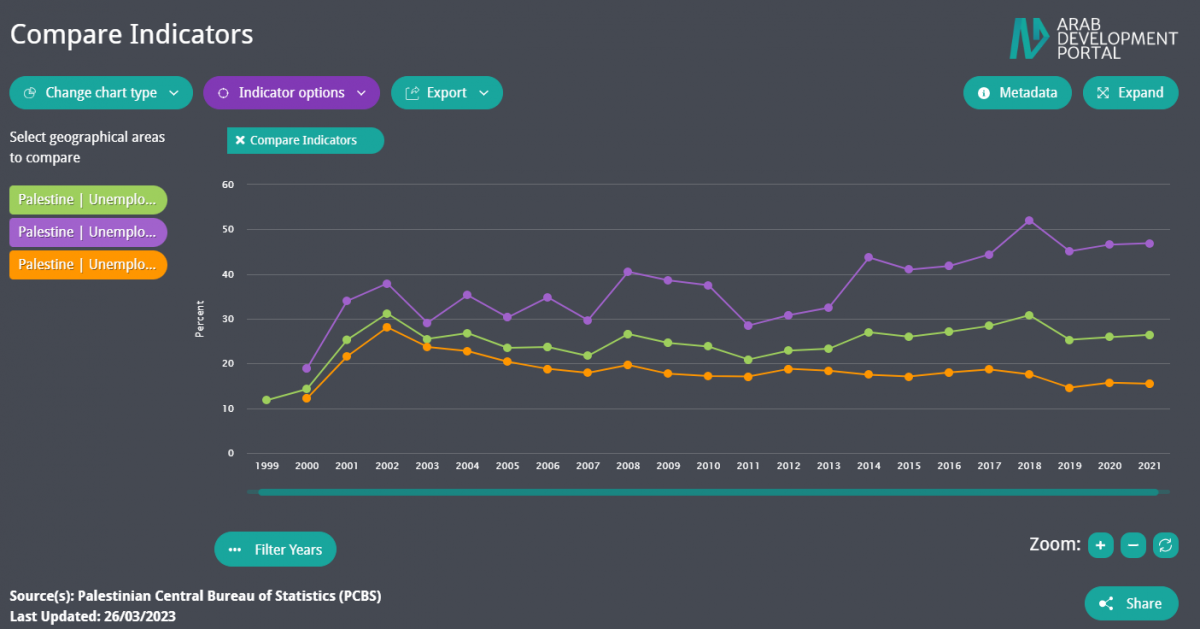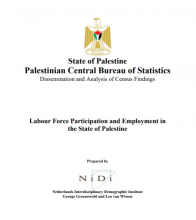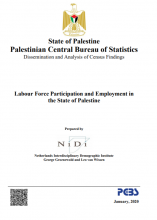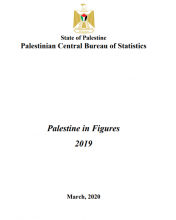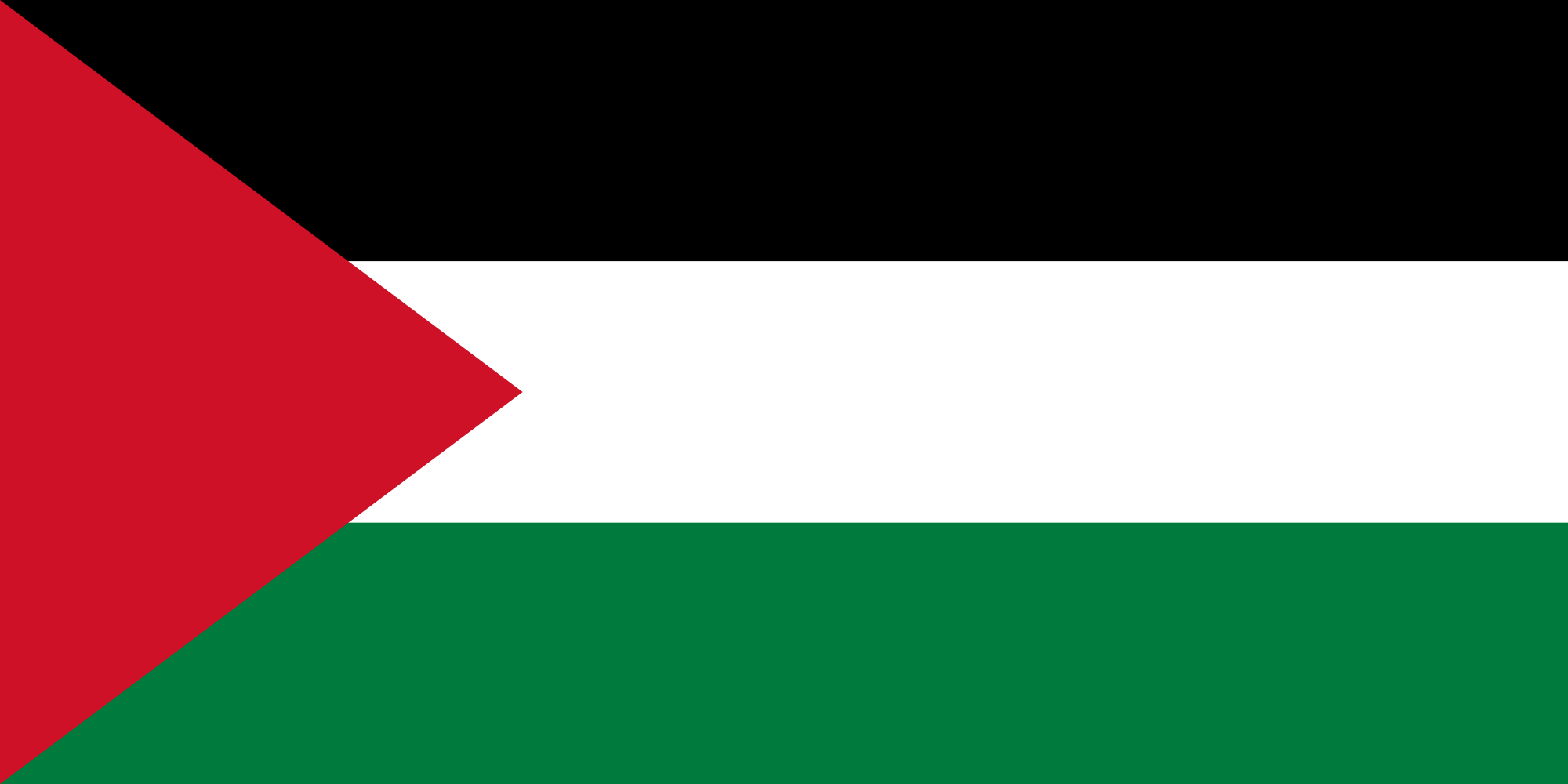 Palestine
Palestine
Long-standing occupation has had significant consequences for the living conditions of the Palestinian people and prospects for development. According to the Palestinian Central Bureau of Statistics (PCBS), the population in the Palestinian territories is estimated at 5.48 million in 2023[1] while UNRWA estimates that more than 6.6 million Palestinians in 2022 have been registered as refugees in areas of the West Bank and Gaza and in surrounding host countries - mostly in Jordan (2.54 million), Lebanon (557,342) and Syria (674,455).[2]
The COVID-19 pandemic struck a weakened economy that has been suffering from deteriorating economic and humanitarian conditions since 2018 with persistent fiscal deficits, high unemployment, increasing poverty, especially in Gaza, and unceasingly decreasing levels of international support.[4]
The second sharpest contractions in economic activity in Palestine— estimated by the IMF at -11.3 percent in 2020—is due to the combined effect of i) the COVID-19 outbreak and the resulting severe economic slowdown, ii) the Palestinian Authority’s decision to halt almost all bilateral contacts with Israel, between May and November 2020, including refusing to accept the tax clearance revenues [1] that Israel collects on its behalf and, iii) the Palestinian Authority’s limited fiscal space and monetary policy tools.[4] The IMF estimated a recovery of the economy in 2021 with growth returning to 7 percent in 2021 and 3.9 percent in 2022.[5]
The political standoff with the Government of Israel over clearance revenues and the economic contraction have significantly reduced the Palestinian Authority’s capacity to pay salaries of public sector employees and deliver services and maintain social safety nets. While coordination with Israel was resumed by mid-November 2020 the impacts have not been fully assessed yet.[4]
The structure of the Palestinian economy has transformed dramatically over the last two decades. Growth has been mainly driven by the construction, retail, and services sectors, while the manufacturing and agriculture sectors contracted by around 40 percent and 75 percent, respectively compared to the late 1990s. During the same period, the public service sector, mostly financed by donors, expanded by 60 percent.[4] GDP growth is also negatively affected by low exports — constrained by the ongoing trade restrictions and contributing to only 16 percent of GDP in 2020— and high imports, amounting to 51 percent of GDP in 2020.[4] In general, trade as a percentage of GDP represented 67.2 percent in 2020, it increased to 73 percent and 85.9 percent in 2021 and 2022 respectively. [3] The structural conditions of Israeli occupation have impeded the private sector, and thus generation of sufficient jobs to absorb entrants to the labor force.*
Palestine suffers from alarming unemployment rates and the outbreak of Covid-19 further impacted employment levels, especially in sectors affected by lockdown and social distancing measures, namely tourism, restaurants, construction, and workers that cross to Israel.[4] In Gaza, 46.6 percent of the labor force were unemployed in 2020 and 46.9 percent in 2021 while the West Bank recorded an unemployment rate of 15.5 and 15.7 percent over the same period. Overall, the unemployment rate for the Palestinian territories reached 25.9 percent in 2020 and 26.4 in 2021, with unemployment being particularly high among women at 42.9 percent – compared to 22.4 percent for men– and youth at 41.7 percent, reaching a dramatic 64.5 percent among female youth.[1] Palestinian refugees also suffer from high unemployment rates reaching 56 percent in Lebanon.[7]
As per The World Bank’s projections, the poverty rate has been constantly increasing since 2016 reaching 28.9 percent in 2020, compared to 22 percent in 2017.[4]
According to the latest 2017 household survey, the proportion of poor households in Gaza reached 53 percent compared to 38.8 percent according to the 2011 household survey while it decreased from 17.8 percent in 2011 to 14 percent in 2017 in the West Bank.[1] In 2021, the proportion of poor households is projected to increase from 53 to 64 percent in Gaza and to double in the West Bank, increasing from 14 to 30 percent.[4] According to the latest UNRWA Crisis Monitoring Report on the Socio-Economic Situation of Palestine Refugees in Lebanon, 93 percent of all Palestine refugees in Lebanon live in poverty.[8]
Poverty is compounded by significant shortages of clean water, and electricity as well as access to sanitation, education, and health care. In particular, Gaza’s health system cannot cope with increasing needs; Israeli authorities granted medical exit access to one in five applications after the 2018–2019 Gaza border protests, and acquiring a permit became increasingly difficult following the outbreak of COVID-19 and the related travel restrictions.[9]
Whatever the situation was before October 2023, the new worsening situation is so massively alarming and frightening. The escalating hostilities, blockades, and lack of adherence to international humanitarian and human rights law have left many people without access to life-saving medical services, clean water, education, and livelihoods, and exposed them to a constant risk of violence and abuse.
After the ongoing siege and bombardment of Gaza and the escalating situation in the West Bank, an estimated 3.1 million Palestinians, more than half of the population, require humanitarian assistance; while about 1.8 million Palestinians, or one-third of all households, are currently considered severely or moderately food insecure.[6]
According to the Palestinian Central Bureau of Statistics (PCBS), till the 10th of November 2023, more than 35 billion USD is Palestine’s losses of GDP at the minimum and cumulatively as a result of the siege imposed on Gaza Strip for more than a decade and a half, which is 10 times Gaza's GDP. The suffocating siege on the Gaza Strip for 17 years is depriving the Palestinian economy of about USD 7 billion in tax revenues. Consumer prices increased by 12% during the first month of Israeli aggression against the Gaza Strip. Mineral water prices increased by 74%, diesel prices increased by 129% and gasoline prices by 118%. Gaza Strip has never witnessed before such an increase in prices, even in the July-August war of 2014. The purchasing power of Palestinian households in the Gaza Strip dropped by 11% in comparison to September 2023.
A third of the private sector establishments stopped production because of an almost complete halt in production for about a thousand establishments in the Gaza Strip. Most workers in the Gaza Strip are unemployed, which is estimated at more than 147 thousand workers. Losses amounted to more than 713 million US dollars during October 2023 in Palestine as a result of an almost complete cessation of production in the Gaza Strip and the repercussions of the aggression, amounting to the equivalent of 24 million US dollars per day, excluding direct losses in property and assets, which exceeded 2.5 billion US dollars in the Gaza Strip according to initial reports.
Till the 2nd of March 2024, there were 30738 Martyrs, 76183 injured, 2 million IDPs, and 355 thousand damaged housing units.
This overview was last updated in November 2023. Priority is given to the latest available official data published by national statistical offices and/or public institutions.
Sources:
[1] Palestinian Central Bureau of Statistics (PCBS). 2023. [ONLINE] Available at http://www.pcbs.gov.ps [Accessed 10 November 2023].
[2] The United Nations Relief and Works Agency for Palestine Refugees in the Near East (UNRWA). 2023. Statistics bulletin [ONLINE] Available at: https://www.unrwa.org/what-we-do/unrwa-statistics-bulletin [Accessed 10 November 2023].
[3] The World Bank. 2023. World Development Indicators. [ONLINE] Available at: https://databank.worldbank.org/source/world-development-indicators [Accessed 23 August 2023].
[4] The World Bank. 2021. Economic Monitoring Report to the Ad Hoc Liaison Committee (English). [ONLINE] Available at: http://documents.worldbank.org/curated/en/859981613598235681/Economic-Monitoring-Report-to-the-Ad-Hoc-Liaison-Committee [Accessed 24 May 2021].
[5] International Monetary Fund (IMF). 2023. World Economic Outlook. [ONLINE] Available at:
https://www.imf.org/en/Publications/SPROLLs/world-economic-outlook-databases#sort=%40imfdate%20descending [Accessed 24 October 2023].
[6] UNOCHA. 2023. Global Humanitarian Overview. [ONLINE] Available at: https://gho.unocha.org/occupied-palestinian-territory ; https://humanitarianaction.info/plan/1186 [Accessed 10 November 2023].
[7] United Nations International Children's Emergency Fund (UNICEF) Lebanon. 2020. Palestinian Programme. [ONLINE] Available at: https://www.unicef.org/lebanon/palestinian-programme [Accessed 21 May 2021].
[8] The United Nations Relief and Works Agency for Palestine Refugees in the Near East (UNRWA). 2022. Palestine refugees in Lebanon teeter on the edge of existence [ONLINE] Available at: https://www.unrwa.org/newsroom/photos/palestine-refugees-lebanon-teeter-edge-existence [Accessed 10 November 2023].
[9] Palestinian Central Bureau of Statistics (PCBS). 2023. Various press release [ONLINE] Available at https://www.pcbs.gov.ps/portals/_pcbs/PressRelease/Press_En_GazaIsraeliSiege2023E.pdf; https://www.pcbs.gov.ps/site/512/default.aspx?tabID=512&lang=en&ItemID=4626&mid=3171&wversion=Staging; [Accessed 10 November 2023].
Data Highlights
-
The unemployment rate in Palestine reached 46.9 in 2021. The disparity is high between West Bank and Gaza where the former registered 15.5 percent and the latter 26.4 percent in 2021.
